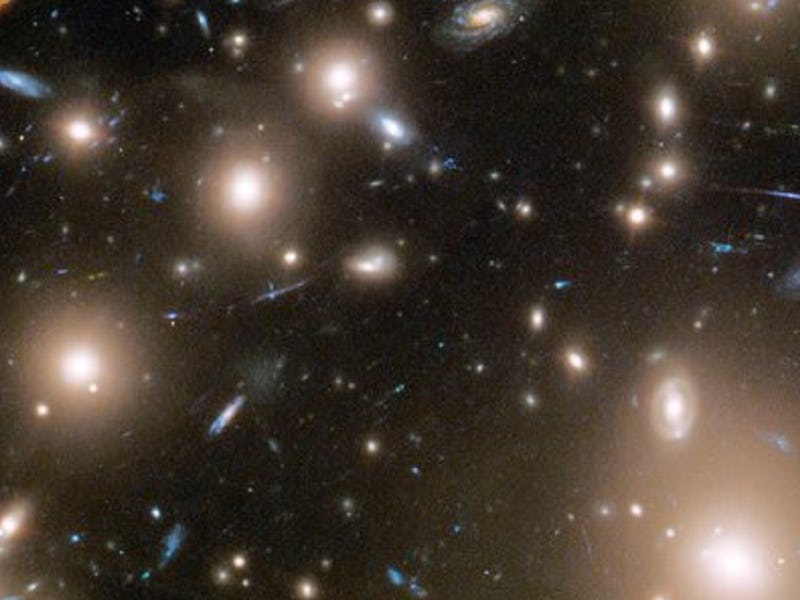Time-lapse view of ancient supernova was hiding in old Hubble data
The cosmic explosion happened 11.5 billion years ago, when the universe was fairly young, and could shed light on the evolution of stars and galaxies.

Astronomers just found a time-lapse view of star exploding 11.5 billion years ago.
Using a massive galaxy cluster as a magnifying lens, the Hubble Space Telescope captured the images of the supernova – but no one noticed for more than a decade, until University of Minnesota astrophysicist Wenlei Chen and his colleagues spent some time poring over old Hubble data, looking for what astronomers call transient events — things like supernovae, that appear suddenly, move, or change fast enough to be noticed against the much steadier background of the universe.
They found what they were looking for, and they recently published their results in the journal Nature.
What’s New — A team of astronomers poring over decade-old data from Hubble discovered the fiery death throes of one of the universe’s earliest stars. After burning out all its nuclear fuel, the red supergiant star, 11.5 billion light years away, exploded in a supernova. And 11.5 billion years later, in December 2010, the light of that stellar cataclysm reached the Hubble Space Telescope.
This set of Hubble images is labelled to show the three different views of the distant supernova at different times.
But as the light from the distant supernova crossed the universe, there was something big in its way: a cluster of galaxies called Abell 370. The galaxy cluster is so massive that its gravity bends spacetime, so light has to follow that curved path around the cluster instead of shining straight through it. The result is like shining light through a curved glass lens, but on a cosmic scale.
Light arrives at the other side of this gravitational lens slightly distorted but also magnified, which means astronomers can use gravitational lenses like Abell 370 and another galaxy cluster called SMACS 0723 to look deeper into the universe than they could with just telescopes like Hubble and the James Webb Space Telescope.
Gravitational lenses sometimes offer astronomers multiple views of the same object, thanks to the way light gets refracted by the lens. In this case, however, Chen and his colleagues realized they were looking at three snapshots of the distant supernova from different points in time. Apparently, the supernova’s afterglow curved along three different paths around the mass of Abell 370, and each path was a different length. The light all converged at the same time in the spot on the other side of the galaxy cluster (the side facing us) at the same time, but it had left the supernova at three different times in the past.
This diagram shows how light from the distant supernova got bent onto the three different paths by the gravity of galaxy cluster Abell 370.
The result is basically a time-lapse view of the supernova flaring to life and then fading, starting about five hours after the star exploded.
Why It Matters — This is the first time astronomers have gotten a detailed look at a supernova from so far back in the universe’s history, and it could shed light (both ultraviolet and visible, thanks to Hubble’s instruments) on the earliest generations of giant stars.
At the moment, astrophysicists aren’t sure whether the giant stars that formed billions of years ago, when the universe was relatively young, were made up of a different mix of chemicals than the ones closer to home, in the more mature (and more recent) universe. Observations like this one could help answer that question.
Within a few hours after a supernova, the light from the explosion starts to fade, and the debris cloud of heated gas starts to cool. How fast the gas cloud cools, and how bright it shows at the beginning, depends on the original size of the star — which means that studying a supernova is a good way to piece together information about a dead star. It’s like a cosmic crime scene investigation.
Chen and his colleagues measured how their distant supernova dimmed over time, starting just a few hours after the blast. As it cooled, the light faded and turned redder, from ultraviolet into visible light. And they used that information to calculate that the star that exploded had once been a red supergiant star about 530 times wider than our Sun.
By studying the specific wavelengths of light from the supernova in more detail, they’ll also learn about the chemical makeup of the star.
What’s Next — In the coming year, Chen and colleagues will also use Webb’s infrared instruments — which are built to see much fainter light, in longer wavelengths than Hubble — to look even further into the universe for older, more distant supernovae.